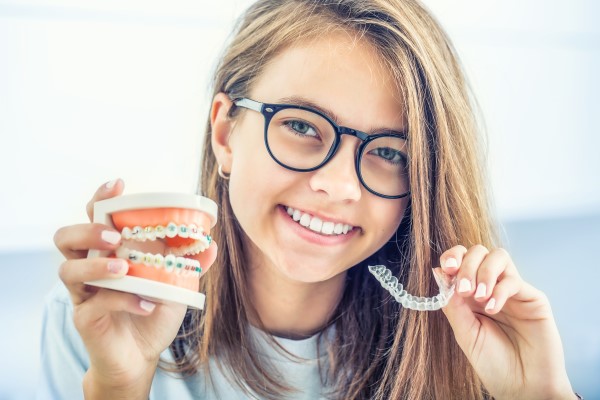Invisalign vs. Braces: Exploring Your Options

Dentists frequently recommend either Invisalign® clear aligners or traditional metal braces for patients who experience issues with teeth such as the following:
- Gapping
- Crowding
- Misalignment
- Protrusion
What is the difference?
There are pluses and minuses to both options. These are some common considerations:
Discretion
Braces consist of metal brackets that are glued to the teeth's surface to support wires held in place with rubber bands. They are highly visible, which patients may find unappealing, though contemporary versions can use this visibility to create fashions statements with colorful wires and rubber bands. Invisible aligners consist of clear trays that fit over the teeth and are barely noticeable when smiling or speaking.
Comfort
Strong glue keeps metal braces adhered to teeth at all times. The metal can rub against the interior of the mouth, causing abrasions or nicks. Clear aligner trays have smooth surfaces that do not irritate the mouth.
Hygiene
Proper cleaning of teeth is critical for preventing cavities and gum disease. Traditional braces can be difficult to navigate when flossing or brushing the gum line. The removable trays of Invisalign® facilitate brushing and flossing and do not interfere with patients' ability to clean all parts of the mouth.
Convenience
Traditional braces can require restrictions on diet and activities. It is necessary to avoid chewing gum or hard foods. Playing sports and musical instruments can lead to accidental damage to the metal and a complicated repair process. The trays of clear aligners can be removed for up to two hours daily without interfering with the efficacy of treatment, allowing for eating and other activities.
Office visits
Wearing traditional braces necessitates dental office visits every six to eight weeks for tightening, observation, replacement of bands and wires, and general cleaning. Patients who opt for clear aligners should visit their doctor for short visits about every four to six weeks to check the status and replace trays.
Who are the recommended candidates for each treatment?
Age may be a factor when choosing between alignment treatments.
Children
Traditional braces that are durable and stay in the mouth, without risk of misplacement, are usually preferred for children. Continuous treatment from metal braces can also effectively influence the proper growth of jaws and bones of children who are still growing.
Teens
Teens who prefer a subtler statement than traditional braces offer may opt for clear aligner trays but must take great care not to lose them, despite their fluid schedules. Parents must provide oversight to ensure that removable trays are worn the recommended 22 out of every 24 hours.
Adults
Both traditional braces and clear aligners work well for adults. Cost is often a factor when choosing traditional braces, but flexibility is equally important for adults who opt for removable trays. Adults usually possess the necessary discipline to care for, clean, and keep track of their aligners.
Conclusion
Traditional metal braces and Invisalign® clear aligners are popular corrective options for teeth. Dental providers often offer both options and can help patients choose a suitable treatment.
Request an appointment here: https://www.dentistofvisalia.com or call Visalia Care Dental at (559) 975-1213 for an appointment in our Visalia office.
Check out what others are saying about our services on Yelp: Read our Yelp reviews.
Related Posts
If you are looking to improve your smile, dental veneers may be the answer. They can be a great way to get a natural-looking smile without needing metal or tooth-colored fillings. This guide will teach you everything you need to know about dental veneers, including the types, benefits, placing process, and how to care for…
Dental veneers may be the most effective option to repair uneven, misshapen, or broken teeth. They can also help reduce gaps in the teeth. Traditional veneers come in two main types: porcelain and composite resin. While both can help you achieve that movie-star smile, they have some differences. This article will explore both porcelain and…
Dental veneers are quick and easy restorations. These thin shells can cover the front part of the teeth. Dental damage and discoloration can go away. You can even gain more strength from this extra layer of protection. Knowing which one can fit you the most can help you decide with your dentist on consultation day.…
Whether caused by an accident, biting on something hard, or untreated decay, quickly addressing a broken tooth can prevent further complications. With prompt attention, a dentist can restore form and function to a broken tooth. Dentists offer several treatment options to repair damage, protect the tooth, and maintain oral health, and understanding these options can…
